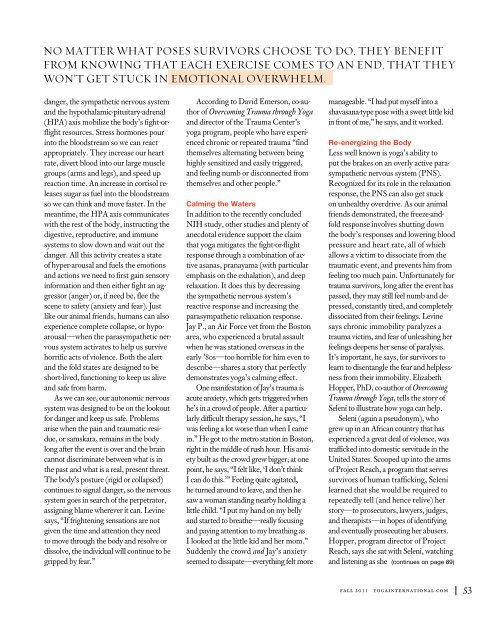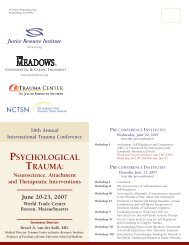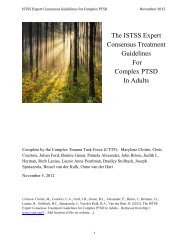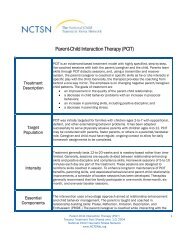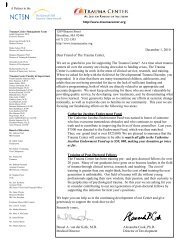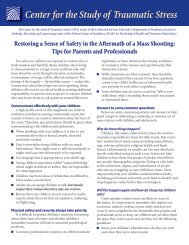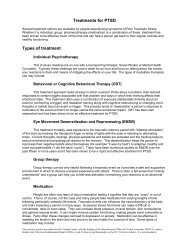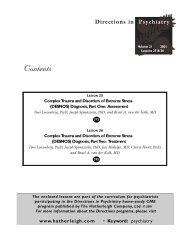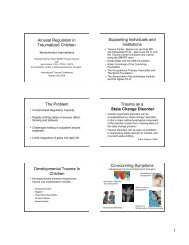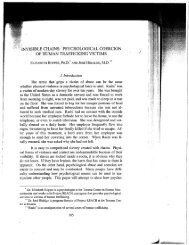Transcending Trauma - The Trauma Center
Transcending Trauma - The Trauma Center
Transcending Trauma - The Trauma Center
You also want an ePaper? Increase the reach of your titles
YUMPU automatically turns print PDFs into web optimized ePapers that Google loves.
NO MATTER WHAT POSES SURVIVORS CHOOSE TO DO, THEY BENEFIT<br />
FROM KNOWING THAT EACH EXERCISE COMES TO AN END, THAT THEY<br />
WON’T GET STUCK IN EMOTIONAL OVERWHELM.<br />
danger, the sympathetic nervous system<br />
and the hypothalamic-pituitary-adrenal<br />
(HPA) axis mobilize the body’s fight-orflight<br />
resources. Stress hormones pour<br />
into the bloodstream so we can react<br />
appropriately. <strong>The</strong>y increase our heart<br />
rate, divert blood into our large muscle<br />
groups (arms and legs), and speed up<br />
reaction time. An increase in cortisol releases<br />
sugar as fuel into the bloodstream<br />
so we can think and move faster. In the<br />
meantime, the HPA axis communicates<br />
with the rest of the body, instructing the<br />
digestive, reproductive, and immune<br />
systems to slow down and wait out the<br />
danger. All this activity creates a state<br />
of hyper-arousal and fuels the emotions<br />
and actions we need to first gain sensory<br />
information and then either fight an aggressor<br />
(anger) or, if need be, flee the<br />
scene to safety (anxiety and fear). Just<br />
like our animal friends, humans can also<br />
experience complete collapse, or hypoarousal—when<br />
the parasympathetic nervous<br />
system activates to help us survive<br />
horrific acts of violence. Both the alert<br />
and the fold states are designed to be<br />
short-lived, functioning to keep us alive<br />
and safe from harm.<br />
As we can see, our autonomic nervous<br />
system was designed to be on the lookout<br />
for danger and keep us safe. Problems<br />
arise when the pain and traumatic residue,<br />
or samskara, remains in the body<br />
long after the event is over and the brain<br />
cannot discriminate between what is in<br />
the past and what is a real, present threat.<br />
<strong>The</strong> body’s posture (rigid or collapsed)<br />
continues to signal danger, so the nervous<br />
system goes in search of the perpetrator,<br />
assigning blame wherever it can. Levine<br />
says, “If frightening sensations are not<br />
given the time and attention they need<br />
to move through the body and resolve or<br />
dissolve, the individual will continue to be<br />
gripped by fear.”<br />
According to David Emerson, co-author<br />
of Overcoming <strong>Trauma</strong> through Yoga<br />
and director of the <strong>Trauma</strong> <strong>Center</strong>’s<br />
yoga program, people who have experienced<br />
chronic or repeated trauma “find<br />
themselves alternating between being<br />
highly sensitized and easily triggered,<br />
and feeling numb or disconnected from<br />
themselves and other people.”<br />
Calming the Waters<br />
In addition to the recently concluded<br />
NIH study, other studies and plenty of<br />
anecdotal evidence support the claim<br />
that yoga mitigates the fight-or-flight<br />
response through a combination of active<br />
asanas, pranayama (with particular<br />
emphasis on the exhalation), and deep<br />
relaxation. It does this by decreasing<br />
the sympathetic nervous system’s<br />
reactive response and increasing the<br />
parasympathetic relaxation response.<br />
Jay P., an Air Force vet from the Boston<br />
area, who experienced a brutal assault<br />
when he was stationed overseas in the<br />
early ’80s—too horrible for him even to<br />
describe—shares a story that perfectly<br />
demonstrates yoga’s calming effect.<br />
One manifestation of Jay’s trauma is<br />
acute anxiety, which gets triggered when<br />
he’s in a crowd of people. After a particularly<br />
difficult therapy session, he says, “I<br />
was feeling a lot worse than when I came<br />
in.” He got to the metro station in Boston,<br />
right in the middle of rush hour. His anxiety<br />
built as the crowd grew bigger; at one<br />
point, he says, “I felt like, ‘I don’t think<br />
I can do this.’” Feeling quite agitated,<br />
he turned around to leave, and then he<br />
saw a woman standing nearby holding a<br />
little child. “I put my hand on my belly<br />
and started to breathe—really focusing<br />
and paying attention to my breathing as<br />
I looked at the little kid and her mom.”<br />
Suddenly the crowd and Jay’s anxiety<br />
seemed to dissipate—everything felt more<br />
manageable. “I had put myself into a<br />
shavasana-type pose with a sweet little kid<br />
in front of me,” he says, and it worked.<br />
Re-energizing the Body<br />
Less well known is yoga’s ability to<br />
put the brakes on an overly active parasympathetic<br />
nervous system (PNS).<br />
Recognized for its role in the relaxation<br />
response, the PNS can also get stuck<br />
on unhealthy overdrive. As our animal<br />
friends demonstrated, the freeze-andfold<br />
response involves shutting down<br />
the body’s responses and lowering blood<br />
pressure and heart rate, all of which<br />
allows a victim to dissociate from the<br />
traumatic event, and prevents him from<br />
feeling too much pain. Unfortunately for<br />
trauma survivors, long after the event has<br />
passed, they may still feel numb and depressed,<br />
constantly tired, and completely<br />
dissociated from their feelings. Levine<br />
says chronic immobility paralyzes a<br />
trauma victim, and fear of unleashing her<br />
feelings deepens her sense of paralysis.<br />
It’s important, he says, for survivors to<br />
learn to disentangle the fear and helplessness<br />
from their immobility. Elizabeth<br />
Hopper, PhD, co-author of Overcoming<br />
<strong>Trauma</strong> through Yoga, tells the story of<br />
Seleni to illustrate how yoga can help.<br />
Seleni (again a pseudonym), who<br />
grew up in an African country that has<br />
experienced a great deal of violence, was<br />
trafficked into domestic servitude in the<br />
United States. Scooped up into the arms<br />
of Project Reach, a program that serves<br />
survivors of human trafficking, Seleni<br />
learned that she would be required to<br />
repeatedly tell (and hence relive) her<br />
story—to prosecutors, lawyers, judges,<br />
and therapists—in hopes of identifying<br />
and eventually prosecuting her abusers.<br />
Hopper, program director of Project<br />
Reach, says she sat with Seleni, watching<br />
and listening as she (continues on page 89)<br />
fall 2011 yogainternational.com 53


